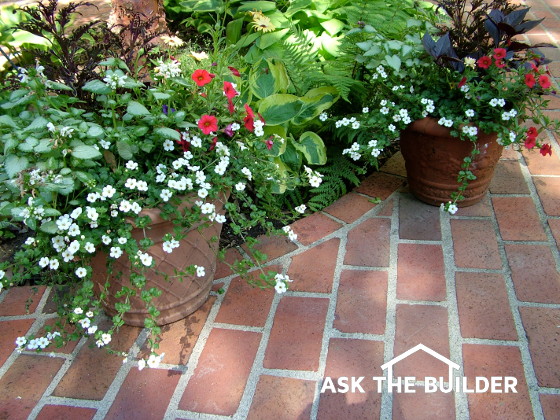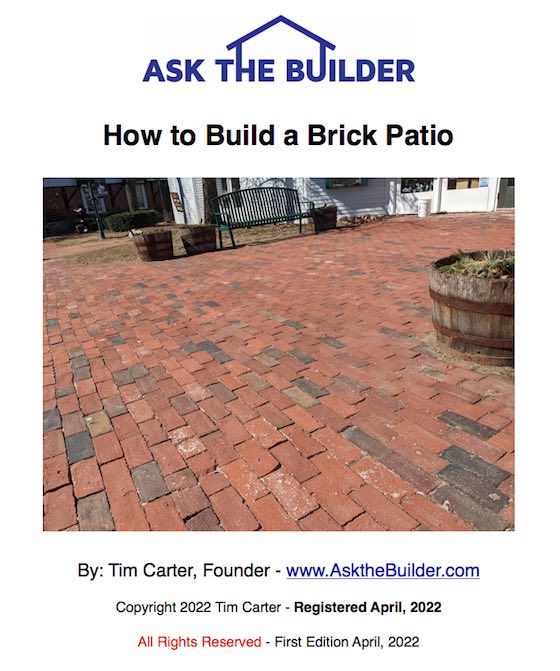Brick Patios – Build One

Clay Paving Brick | This patio was built with traditional clay brick pavers. You can get step-by-step installation instructions to create the EXACT SAME look you see in the photo here They could have been set in sand, but laying them in mortar creates a traditional look and feel. PHOTO CREDIT: Tim Carter Copyright 2022
Clay Brick Patio - Forget About Using Concrete Brick
DEAR TIM: My husband and I are going to build a patio. We want an authentic brick patio. Is there a special brick we should use? What method of installation do you feel is the most permanent? Can you offer any brick laying tips? S. E.
DEAR S. E.: Now here is a subject close to home for me. If you can make it to my house this weekend, you can help me finish my lower brick patio. I've installed thousands of brick in patios, sidewalks and stairways around my current home and my previous residence. They make superb, decorative patio surfaces.
What is Clay Paving Brick?
Clay paving brick is a special brick made from fired clay. It needs to be sufficiently hard to resist years of foot and often motorized traffic. In addition, the brick must have a high skid or slip resistance. Look for a brick that has a rough or wire-cut surface. If you live in a climate that experiences cold weather, be sure to ask if the brick is graded for severe weather (SW). Do not purchase the brick without this guarantee.
What are the Brick Sizes?
Paving brick usually is available in two sizes. Both types are solid with no inner voids. Normally they are 4 inches wide and 8 inches long. I prefer to use the one that is only 1 and 1/2 inches thick. If you expect heavy vehicle traffic you may wish to use a paving brick that is 2 and 3/8 inches thick.
What is the Best Way to Install Clay Paving Brick?
The best way to install clay paving brick is to follow my step-by-step download PDF instructions. These include secret formulas for the best mortar, detailed instructions, illustrations, videos, links to the best tools, and many many tips.
You have several options with respect to installing the brick. You can use a flexible, semi-rigid, or a rigid base system. The flexible base consists of a bed of crushed gravel and sand. A semi-rigid base incorporates a layer of asphalt beneath the paving brick. I happen to prefer the rigid method. This involves mortaring the paving brick to a steel reinforced concrete slab.

This is the cover to my download step-by-step instructions. They're the BEST INSTRUCTIONS on the Internet. Of that there's no doubt. Look and see for yourself.
You begin this project by determining where the top surface of the patio will be. Excavate the ground to a depth of 8 inches. Install the necessary wooden or steel forms to create the shape of the patio. Use 1/2 inch plywood to make gentle or tight curves. The top of the forms should be 2 inches below the anticipated finish surface of the patio (assuming you are using the 1 1/2 inch thick brick).
Once the forms are set, you can install 2 inches of washed pea gravel. While not absolutely necessary, this gravel helps promote drainage beneath the concrete. Now it is time to place the 1/2-inch steel reinforcing bars. Create a gridwork by placing these every two feet in both directions. Place the steel on small pieces of brick so that the steel ends up at least 1.5 inches off the soil and preferably in the middle of the 4-inch-thick slab. Pour the concrete base using a mix with a minimum compressive strength of 4,000 pounds per square inch. Strike the surface of the concrete with a board to remove any high spots.
After the concrete hardens, it's time to lay brick. Begin by installing all of the edge brick first. The brick should be laid in a 1/2 inch thick bed of Portland cement mortar (3 parts sand to 1 part cement). Do not use standard bricklayer's mortar mix! Let the edge brick dry for 1 - 2 days. Stretch a string between the edge brick and begin filling in the center of the patio laying a course at a time. The space between each brick is filled after all the brick are laid. I use a grout bag that resembles a cake icing bag. Mix 1 part fine sand to 1 part cement for this purpose. Let the mixture flow from the bag until it overfills each joint. The mixture will get stiff within 15 - 20 minutes. Scrape off the excess and get ready to party!
I Need More Detailed Instructions - Where Can I Get Them?
Once again, I urge you to download my 13-page step-by-step instructions showing the two methods to install clay paving brick. They come with a satisfaction GUARANTEE.
